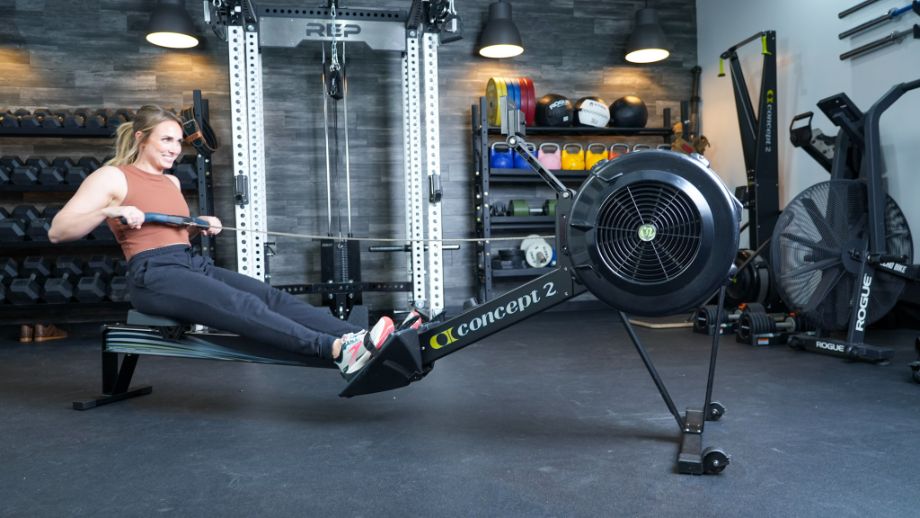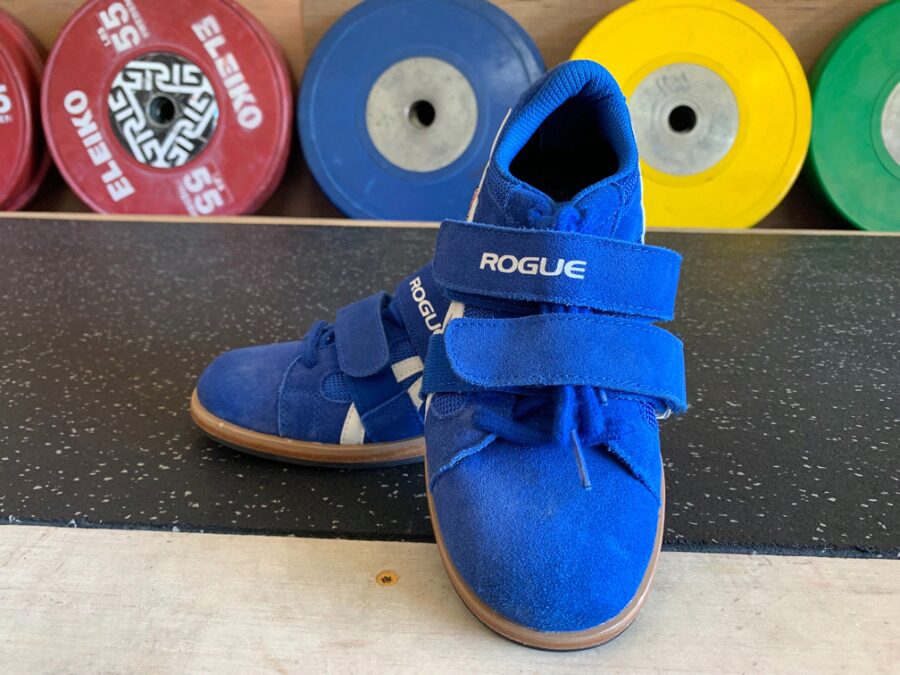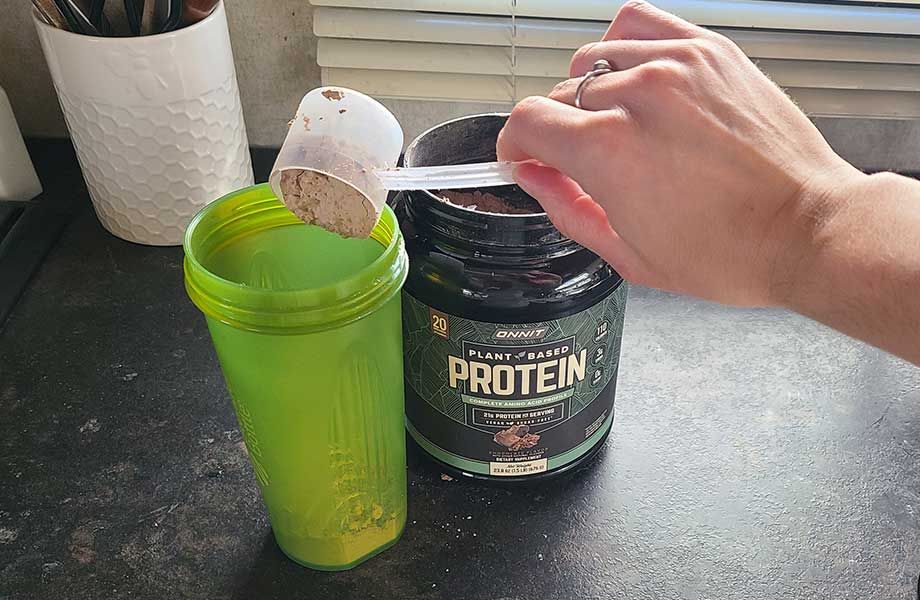These Creative Ways to Use A Rower Are Far From ‘Oar’dinary!
Think all you can do on an indoor row machine is row, row, row on the rail’s fixed path? You might be pleasantly surprised to learn some creative ways to use a rower that have nothing to do with the typical rowing motion whatsoever!
To offer you creativity and variety, we turned to row enthusiast, Eleana, head coach at Orangetheory Fitness Concord. And because Orangetheory includes the rower in almost every coach-instructed led workout, it’s safe to say Eleana knows and loves a thing or a few about rowing.
“All aboard!” Set sail with us as we show you the ropes and voyage into clever rowing exercises and workouts.
Your Rower Is Good for Much More than Rowing
The rowing machine benefits the entire body, as the cardio-based, low-impact exercise targets almost every muscle. Eleana elaborates, “Rowing works about 80% of your muscles. Of that 80%, rowing targets about 60% legs, 20% core, and 20% arms.”
Of course, many go-to rowing machine workouts are equally effective and enjoyable but you can use the rower in creative ways as well. Alternate rowing with various exercises, use the rower to not row at all (we can and will explain!), experience virtual rowing, and more.
Alternate Workouts With Various Exercises
While rowing is a great full-body workout on its own, you can combine it with exercises to challenge muscles in another way—and keep the fitness spark alive between you and your rower! And since rowing is mostly lower-body focused, you can add in more upper-body exercises to round out your workout.
Use the cardio equipment for AMRAP, circuit-style, or HIIT rowing workouts. Simply alternate between rowing and other exercises, as detailed in Workout #1 below.
Perform Non-Rowing Exercises
Did you know you can use your rower to, well, not row at all? The rowing machine can also be used to challenge exercises, including planks and side lunges. You can also use the rower’s seat to help measure your squat depth, including while doing squat pulses.
Experience Virtual Rowing
Instead of zoning out during your rowing workout, immerse yourself in a mesmerizing virtual rowing experience! Virtual rowing doubles down on the concept of workout gamification, which integrates gaming components—like progress bars, badges, and levels—into your workout.
A wide variety of apps connect to various rowers, including the CITYROW GO app that works with its rowing machine (the CITYROW Max) and others like the Concept2 rower. However, some apps are only compatible with certain rowers, so factor that into your decision-making process if in the market to purchase a rowing machine.
(We’re here to ease the purchasing process with this in-depth guide to the best rowing machines. Don’t worry, we’d never row steer you wrong!)
Workout 1: AMRAP Rowing and Bodyweight Workout
Looking to rev up your cardio workout while building strength and balance? This fun, high-intensity AMRAP—as many rounds as possible—rowing workout is for you.
While AMRAPs are often clumped into HIIT (high-intensity interval training), they technically aren’t. HIIT workouts incorporate short and intense exercise intervals followed by periods of rest, but AMRAPs do not include rest—although you certainly are allowed to catch your breath and grab a drink of water!
Why You Should Do It
The total-body workout is high-intensity, meaning it will be intense but also short, sweet, and well worth those challenging minutes. So if you are crunched for time, or simply up for trying a new rowing workout, give this AMRAP a row go.
How To Do It
First and foremost, remember to warm up before entering the meat of the workout. (And cool down afterward!)
For the AMRAP workout, set a timer for 10 minutes and complete as many rounds as possible of the following:
- 500-meter row
- 10 push-ups
- 20 alternating lunges
- 20 bicycle crunches
While the workout features bodyweight exercises, remember you can add free weights or increase the number of reps for an added challenge. Also feel free to add or swap out other exercises into the circuit—like bicep curls, squats, and shoulder presses—to best match your fitness level, goals, and preferences.
You can also make this a fun partner workout! As you’re rowing, your fitness friend can tackle the bodyweight exercises and then swap places once each is finished. As each of you tries your best to complete as many rounds as possible, you’ll naturally be pushing one another to sustain and build momentum until the timer dings.
Workout 2: Targeted Training
If you’ve ever attended Orangetheory Fitness, you know each class focuses on endurance, power, and/or strength. So, naturally, Eleana encourages experimenting with targeted training to expand your rowing horizons.
Why You Should Do It
Targeted training can help enhance your fitness goals, whether it be to leverage your strength while lifting weights, lung capacity and stamina for endurance sports, or power for sprinting and other quick, intense movements.
Rotating between the various types of training can also make you a more well-rounded athlete, which will trickle into your preferred type of training. For instance, if you prefer traditional weight lifting, training endurance can help fight muscle fatigue and keep you training with greater intensity during your sessions.
How To Do It
Targeting your training on the rower consists of changing your timing, power, and intensity. You’ll focus on one or a combination of the following metrics:
- Split time: the time it takes to row 500 meters and provides insight into your intensity and pace; also known as 500m split
- Stroke rate: how many strokes are completed in one minute (s/m)
- Watts: the measure of intensity and power output from the legs
With those terms in mind, use the below cues to focus on endurance, power, and strength-based rowing.
Endurance-focused rowing:
- 1-second drive back, 2-second return forward
- Steadiness and consistency in your rower measurements like stroke rate and watts
- Focus on more manageable stroke rates (about 24-28 s/m)
- Think, “How LONG can I hold/maintain this for?”
Power-focused rowing:
- 1-second drive back, 1-second return forward
- Shorten the stride
- Focus on a lower split time and higher watts and stroke rates (28+)
- Think, “How FAST can I finish this row?”
Strength-focused rowing:
- 1-second drive back, 3-second return forward
- Hard, powerful drive back that mimics a deadlift
- Very slow return forward
- Focus on higher watts with a lower stroke rate (about 22-24 s/m)
- Think, “How HARD can I push off my footplates?”
Workout 3: Active Recovery During Strength Training Workout
Instead of scrolling through Instagram during your strength training rest periods, hop on the rower—not for a social media scrolling seat, but for active recovery.
Active recovery is simply any light activity that assists in the recovery process. It’s often associated with movement on your rest days, though it can also be valuable during your resting periods during the workout itself.
Why You Should Do It
Adding in your active recovery breaks during your strength training exercise can keep blood moving to your muscles. It can also help slow down your heart rate.
How To Do It
Between each lifting set, pace yourself on a rower. If you need (and should) practice proper gym etiquette in a crowded gym, etiquette in a crowded gym, you could also row between each exercise.
Regardless of when you decide to row during your strength-training workout, the key is to not go overboard and approach the rower with intensity. This especially serves true on strength-focused days when the body still needs proper and adequate recovery to feel strong enough for your next lift once the rest period is up.
The targeted stroke rate range will depend on the lifter’s fitness level. Overall, try to not over exceed a stroke rate of 22 s/m.
Creative Exercises To Do On Your Rower
Exercise 1: Plank-to-Pike
When performed correctly, rowing is great for building a strong core. But you can kick those core-building benefits up a notch with (careful) creativity.
Why You Should Do It
The plank is an isometric exercise that activates the core, shoulders, chest, quads, and really all muscles as they work together to stabilize the body.
Adding in the dynamic movement of a pike—especially when stabilizing and balancing the seat of a rower—challenges the targeted muscles of a plank to a greater degree. The pike also gives a gentle stretch to the hamstrings and calves.
How To Do It
- With your back facing the rower’s handle and monitor, get into a plank position—your body should be elongated with the rower’s rail. Carefully place your hands a few inches away from the rail and under your shoulders while hiking your feet on the rower’s seat.
- Keeping your hands firmly on the ground and legs straight, pike your hips up into the air while keeping your core engaged. Your body should resemble an upside-down “V” in the pike position.
- Once you’ve reached the peak position, slowly and carefully lower back down in the plank position for one rep. During the descent, continue to keep your core engaged and avoid dipping the pelvis to avoid lower back strain.
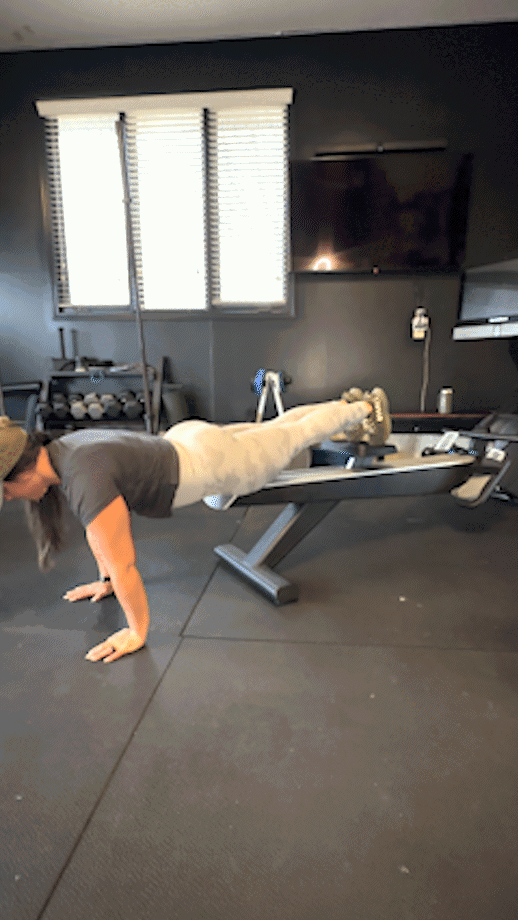
Exercise 2: Plank-to-Bear Crunch
Just like the plank-to-pike, the plank-to-bear crunch is another challenging dynamic movement that works your core “beary” much.
The plank-to-bear crunch is similar to the pike in that you’ll contract your core and drive your feet closer to your chest. But instead of keeping your legs straight, you will bend your knees as you “crunch” your core.
Why You Should Do It
Again, the plank is a great isometric core exercise. But as your feet drive the seat along the rower’s rail into a crunch, you’re contracting the core muscles even more.
How To Do It
- Like the pike-to-plank, have your back facing the rower’s handle and monitor and assume the plank position along the rower’s rail. Carefully place your hands a few inches away from the rail and under your shoulders while your feet onto the rower’s seat.
- While keeping your core engaged, slide your feet (which should be planted firmly on the seat) forward and bend your knees towards your elbows.
- Slide your feet back to the plank’s starting position for one rep.
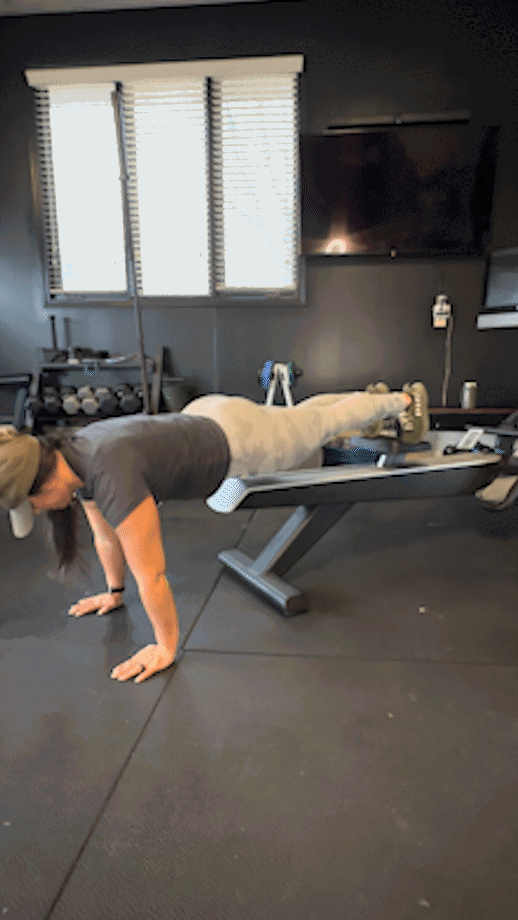
Exercise 3: Sliding Lateral Lunges
Sliding lateral lunges is the leg exercise you didn’t “row” you needed. While challenging, they are great for targeting leg muscles that rowing generally does not.
Why You Should Do It
Rowing is predominantly a lower-body workout that mostly targets the quads, glutes, and hamstrings with each drive. However, the general motion of rowing does not fully activate the abductors and adductors—casually known as the areas of your inner and outer thigh.
Sliding lateral lunges activate the quads, glutes, and hamstrings, as well as the abductors and adductors. Working and strengthening these muscles helps improve stability, balance, and overall lower-body strength. It also helps your body move in various directions beyond walking’s forward motion.
How To Do It
- Stand behind and parallel to the rower and place one foot on the seat. You can either stand with your foot on the ground or be elevated on a higher, sturdy surface like Marcus Filly shows in the video.
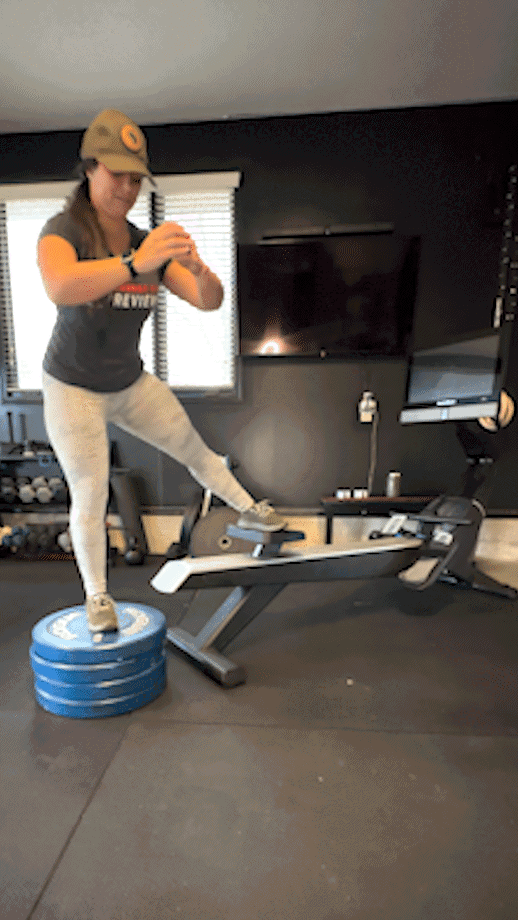
Speaking of Marcus, you gotta check out his garage gym that he showed off to Coop!

- While keeping your stationary foot anchored and your torso upright, slowly drive your hips back and slide your moving foot across the rail as far as you can comfortably and safely reach.
- Bring your hips forward and slide your foot back towards you for one rep. Repeat the movement on the other side.
Rowing Machine Safety

Before trying out new and creative ways to use a rower, first how to use a rowing machine for your utmost safety. Learning the ropes and refining your rowing technique helps prevent misuse injuries like lower back pain.
“One of the most common mistakes I see with rowing begins with not sitting on the rower properly. Unlike popular belief, you should sit on the top of your hamstrings and NOT flat on your butt,” instructs Eleana.
Also, treat each rowing workout and exercise with caution, particularly the exercises when your ‘strings (remember, not flat on glutes) aren’t positioned on the seat. Keep safe on the rower by avoiding these additional rowing mistakes:
- Not having the footplates properly fitted or strapped: Adjust the strap to fit across the widest part of the foot.
- Leaning too far back: “Think 1 o’clock—that’s how far you should lean back,” Eleana advises.
- Rowing without proper order: “The legs should extend first, then the torso leans, then the arms pull back,” instructs Eleana. “It’s the opposite of that on the way forward (back toward the monitor).”
- Falling off the sliding seat: Rowing with proper form and technique will help prevent this.
After you feel confident in your rowing form and technique, now is a great time to paint your workout with creativity. When doing so, we recommend trialing the exercises off the rower first. For instance, get comfortable with the plank-to-pike exercise on the floor before giving it a shot on the rower.
Final Thoughts: Creative Ways to Use a Rower
Rowing is a great workout on its own that provides countless benefits. But once you’ve mastered the fundamental ropes of rowing, you can shake up your workouts with creative ways to use a rower.
Incorporate the rower in your HIIT and AMRAP workouts, swap social media scrolling for active recovery rowing, and immerse yourself into creative virtual rowing experiences. The gliding seat can also challenge bodyweight exercises, including plank-to-bear crunches and sliding lateral lunges.
Truly, the rowing machine offers fitness diversity when approached with creativity. Test the rowing waters and put on your creative cap to shake up your row, row, rowing machine workouts!
FAQs: Creative Ways to Use a Rower
What is the most effective row exercise?
The most effective rowing exercise is the one that floats your boat and you consistently choose to do. For instance, to reap the full benefits of endurance-based rowing, you’ll need to spend time rowing with endurance top of mind.
You should also track your pre-determined metrics—like the amount of time you can sustain a stroke rate—so you can objectively see your progress. To continuously improve your cardiovascular fitness, continuously challenge yourself to hit new times and other milestones.
How can I make my rowing more interesting?
You can make rowing more interesting by joining a virtual class, incorporating it into an AMRAP workout, and targeting your rowing training like endurance, strength, and/or power-focused. Various bodyweight exercises—like plank-to-pikes and sliding lateral lunges—can also be challenged using the sliding seat on the rower.
What other exercises can you do with a rower?
Aside from sitting on the rower during your entire workout, you can alternate between rowing and other exercises during an AMRAP, HIIT, or circuit-style workout. Sliding lateral lunges and other bodyweight exercises can be performed on the seat of the rower as well.
How do you make a rower more challenging?
One of the simplest ways to make rowing more challenging is by trying out a new training style. So if you mostly focus on endurance and distance training, try challenging yourself to row with more controlled intensity and power.
Cycling through rowing and bodyweight movements in an AMRAP is also a surefire way to make any workout a challenge, as well as competing against others in a virtual rowing class.


